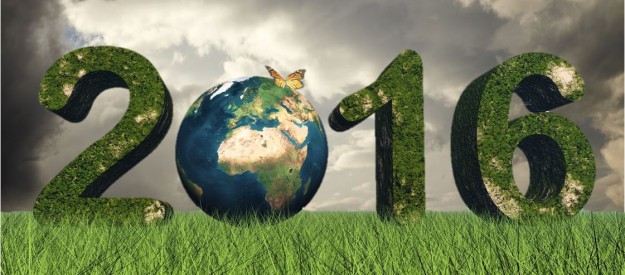More important for us, what, then are our top ten ecological stories? Why? Is one of them the election of Don Trump and the changes he will soon usher in? Much thought should be given to this right now, as you are with your goals for 2017. Looking back as a foundation for looking forward will give us solid footing and an edge. We'd like to see more people set simple goals around efficiency, updating to better fuel use in transportation, buying more local food, etc, as the base for a better year.
We will finish this up tomorrow and give you a link to the blog.
Regardless, God bless you all as you enter a brand new year, full of unbelievable promise for us and the planet.

2016 came in roaring on the momentum of Pope Francis’s eco-encyclical Laudato Si’. Then it stumbled here and there as uncertainty came from unexpected winds. And now in these last days, the Catholic eco-sphere is filled with worry but also, as always, with hope in the healing grace of God and the Gospel of Life.
And so away we go with the top ten Catholic eco-stories of 2016.
10: The momentum of Laudato Si’
Pope Francis’s eco-encyclical was the big story of 2015 and its momentum and influence hammered away into 2016 with an omnipresence that graced even secular gatherings, like the COP 22 climate talks. Eco groups and Catholic religious orders, parishes, dioceses, and schools continued to study the pontiff’s words and (as we will see) infuse them into the life of the Church. Rome itself continued to shine the light of Laudato Si’ within its own prayer life and its engagement of the intersection of the natural sciences and public policy. The result of all this? One of the most impressive consequences coming out of the encyclical is arguably the movement in 2016 by many Catholic groups to divest from fossil fuels—which no doubt will be a top story in 2017.
9: The Season of Creation
You can also thank Laudato Si’ for the growth in the celebration of the Season of Creation. From September 1st (the traditional day of prayer for creation among the Eastern Orthodox) to October 4th (the Feast of Saint Francis of Assisi), the Seasonhas been a longtime ecumenical observance among many Christians. Then it was taken to great heights in the Filipino Catholic Church, and from there (with the help of Manila’s Cardinal Luis Tagle and his close friend Pope Francis) the Season of Creation became an annual event in the life of the universal Church. 2016 then saw a growing number of parishes and dioceses worldwide joining in, which is why this year may well be remembered for making the Season of Creation a Catholic tradition worldwide.
8: Local church advocacy
Speaking of the Philippines, Catholics in that nation raised loud voices in 2016 for eco-protection issues and interrelated social ones. Protesting massive developments, the continued use of coal, and the treatment of the indigenous, Catholic Filipinos continue to show the rest of us what it means to take seriously Benedict XVI’s demand that we bring our eco concerns into the public square—a demand, of course, championed by his successor. Throughout South America, Africa, and Oceania, the Church continues to find and raise its eco-voice. One hopes that 2017 will see growing levels of eco-engagement by even more bishops, priests, and laity, especially here in the Global North.
7: Diocese, parishes, and religious orders going green
Local Catholic communities are not just demanding that others live out Laudato Si’. They’re living it themselves—or at least trying to. While energy efficiency and renewable power sources are some of the more common ways that parishes are “going green,” there have been other efforts related to stormwater management, organic landscaping, and composting and waste reduction. Entire dioceses are getting into the act, especially (as always) in the Philippines. In the United States Stockton, California has long been recognized as a leader in environmental stewardship, while on the other coast, Burlington, Vermont just announced its upcoming Year of Creation for 2017. Then there are the religious orders undertaking massive eco-initiatives, notably the Columbans and the Mercies—especially that order’s Western Province in Ireland, which in 2016 published Walking Gently on the Earth. Helping Catholic communities figure out what practical steps to take—in part by learning from what other communities and parishes have already done—groups like the Global Catholic Climate Movement, the US-based Catholic Climate Covenant, Ecojesuit, and Catholic Youth Network for Environmental Sustainability in Africa have provided lots of free information in the form of educational resources and parish eco-guides to assist in work that will most certainly be found in the top stories of 2017.
6: Saving the relic
While all this advocacy and education is happening, some Catholic eco-groups, like the Saint Kateri Tekakwitha Conservation Center in North America, have been quietly stoking more spiritual fires. It was indeed the quiet Saint Kateri center that rocked the church in the United States in 2016 with its deft and determined recovery of a first-class relic of Saint Kateri that was being peddled on eBay. The group quickly spread the word online, raised over $5,000, and brought Kateri home, where the relic is now safe at the Saint Kateri shrine in upstate New York, awaiting ecclesial authentication and approval for veneration. In all, the use of twenty-first century technology to save the relic of a seventeenth-century saint (and patron of ecology) reminds us that the end game of the Catholic involvement of ecology is both worldly and spiritual. Read more here about this big story.

No comments:
Post a Comment